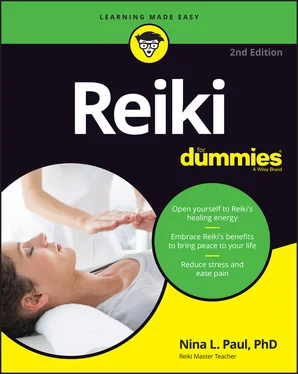Hawayo Takata: Dr. Hayashi took the important step to train a Hawaiian woman, Hawayo Takata (see the next section). Because of his actions, Reiki spread to another continent.
Chiyoko Yamaguchi: Chiyoko Yamaguchi and her son taught Jikiden Reiki, and one of her former students teaches Komyo Reiki Do. (See Appendix Afor contact information about these two Reiki branches.)
Bringing Reiki from East to West: Hawayo Takata
Hawayo Takata plays a critical role in Reiki history because she brought the practice of Reiki from Japan to the West. Prior to this, Reiki was practiced only in Japan.
Though Hawayo Takata was an American citizen born in the then-territory of Hawaii, she was of Japanese heritage, so she was able to walk in both Eastern and Western worlds.
Hawayo Takata was born on Christmas Eve 1900 and named for her birthplace of Hawaii. Her parents had emigrated from Japan. To take care of personal business and health matters, Hawayo Takata traveled to Japan in 1935.
Learning Reiki for herself
While Hawayo Takata was on the operating table to take care of some gastrointestinal issues, she heard a voice tell her not to have surgery. She then asked whether a nonsurgical solution for her health was possible. She was directed to Chujiro Hayashi’s Reiki clinic.
After a few weeks, she was so impressed with the Reiki method that she was able to persuade Chujiro Hayashi to teach it to her. Her daily Reiki treatments continued for several months, after which she was cured of her illness.
For decades, Hawayo Takata practiced Reiki in Hawaii and the mainland United States. In 1976 she trained her first Reiki Master and ended up training 22 Reiki Masters before she died in 1980. In the West, a Reiki Master has the ability to teach other Reiki students.
Here are the names of Takata’s Reiki Masters:
George Araki
Dorothy Baba
Ursula Baylow
Rick Bockner
Patricia Bowling Ewing
Barbara Brown
Fran Brown
Phyllis Lei Furumoto
Beth Gray
John Harvey Gray
Iris Ishikuro
Harry Kuboi
Ethel Lombardi
Barbara McCullough
Mary McFadyen
Paul Mitchell
Bethel Phaigh
Barbara Weber Ray
Shinobu Saito
Virginia Samdahl
Wanja Twan
Kay Yamashita
Hawayo Takata’s students, and their succession of students, brought Reiki to North America, Europe, and other countries.
She continued to study with Chujiro Hayashi and then brought the system back to her native Hawaii. Hayashi and his daughter followed her to Hawaii to help her set up a Reiki practice.
Takata’s versions of Reiki history
Many of the stories that Hawayo Takata and her students told and that were subsequently repeated in many books about Reiki history were later found to be inaccurate. For example, she told stories that Mikao Usui was a Christian minister and that he studied at the University of Chicago. Reiki historians later found that these were untrue.
A generation of Reiki students learned old versions of Reiki history told by Takata. In today’s world, the embellished story of Reiki is no longer necessary to keep Reiki alive. (See the nearby sidebar “The true role of Hawayo Takata.”)
THE TRUE ROLE OF HAWAYO TAKATA
Hawayo Takata did what she could for Reiki to survive in the Western world. Reiki historians showed that some of the stories relayed by Takata weren’t true. However, history now shows Takata to be the Reiki heroine that she truly was. She managed to preserve a Japanese healing method in Hawaii, the very state that was bombed by the Japanese at Pearl Harbor.
Hawayo Takata fought discrimination on both sides, as the Japanese saw her as an American. Even today, the Usui Reiki Ryoho Gakkai doesn’t train those from other countries or admit them as members of their organization. It’s a miracle that Chujiro Hayashi (see the earlier section “ Exploring the Medical Approach: Chujiro Hayashi”) trained her and helped her with her Reiki practice.
Her work brought Reiki to the West, and students of her system even taught in Japan. It had been unknown that there were active Reiki lineages that had survived in Japan. This spread of Reiki encouraged more Japanese Reiki practitioners to communicate, teach, and practice Reiki. It’s impossible to know for sure where Reiki would be today without Takata, but it’s certain that she played a seminal role in Reiki history.
Seeing Reiki in Japan and the West
When Hawayo Takata (covered earlier in this chapter) died, none of her students were aware that Reiki existed in Japan. Her Masters students tried to put together their notes from the different teachings that Takata had given each of them. Some of her students wrote books or created new Reiki branches.
There was no mutually agreed-upon successor to Takata. At this time, the Reiki Alliance is the most prominent branch from Takata, which had Phyllis Lei Furumoto as the successor.
After Mikao Usui died in 1926, followers of his system in Japan went on quietly without much public notice.
People in the West who studied Reiki weren’t even aware that Reiki had survived in Japan. It appears that Japanese Reiki was lying in wait like a dormant seed. In 1985, Mieko Mitsui, a student of Barbara Weber Ray, went to Japan and began to teach some levels of Reiki. Japanese people were eager to study Reiki, and other teachers from the West also taught in Japan.
Eventually, the increased interest in Reiki stimulated some Japanese-trained Reiki practitioners and teachers to come out of hiding and begin teaching their methods.
Japanese and Western Reiki today
Today a distinction is made between Japanese and Western Reiki:
Japanese Reiki is considered to be more faithful to Mikao Usui’s original style.
Western Reiki has been altered by changes made by Chujiro Hayashi and Hawayo Takata, and even further altered by successive Reiki teachers.
Japanese Reiki is now being studied in the West as Reiki students yearn to discover its roots. As information on Japanese techniques becomes available, Western branches are incorporating this information into their teachings.
Takata’s original teachings are also being studied, and the connections to the Usui-Hayashi teachings are apparent.
LISTING THE REIKI TECHNIQUES
Mikao Usui, Chujiro Hayashi, and Hawayo Takata taught many Reiki techniques, and some branches have also incorporated new Western techniques. Here’s a list of the most common Reiki techniques, what they’re used for, and where you can find more information about them in this book.
| Name of Reiki Technique |
Description |
More Information in Chapter: |
| Aura cleansing |
Sweeping energy |
13 |
| Byosen Reikhan Ho |
Scanning and sensing imbalance in the body |
11 |
| Chakra balancing |
Complementary method to Reiki treatment |
11 |
| Crystal healing |
Complementary method to Reiki treatment |
12 |
| Distant healing |
Remote healing |
15 |
| Gassho meditation |
Prayerful hands meditation method |
9 |
| Group distant healing |
Sending healing as a group |
14 |
| Gyosi Ho |
Healing by staring |
11 |
| Hand positions |
Placement of hands for Reiki treatment |
11 |
| Hatsurei Ho meditation |
Generating spiritual energy |
9 |
| Healing the past and future |
Sending Reiki across time |
15 |
| Hui Yin contraction |
Nontraditional technique to concentrate energy |
9 |
| Jakikiri Joka Ho |
Cleaning inanimate objects (crystals) |
12 |
| Joshin Kokyo Ho |
Focusing the mind with your breath |
9 |
| Kenyoku Ho |
Dry energy bathing |
13 |
| Koki Ho |
Healing with the breath |
11 |
| Nentatsu Ho |
Mental/deprogramming technique to treat habitual thought |
16 |
| Reiji Ho |
Being guided by spirit |
11 |
| Reiki box |
Form of distant healing |
15 |
| Reiki Mawashi |
Sending energy around a group circle |
14 |
| Reiki Shower |
Shower of Reiki energy coming down |
10 |
| Seishin Toitsu |
Attaining a unified mind |
9 |
| Self-Reiki |
Placement of hands on self for Reiki treatment |
10 |
| Shuchu Reiki |
Treatment by many practitioners |
14 |
Looking at Reiki Branch Lineage
Читать дальше












